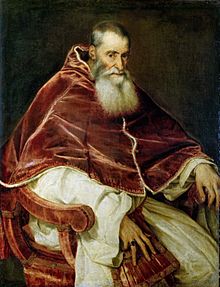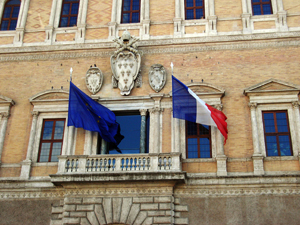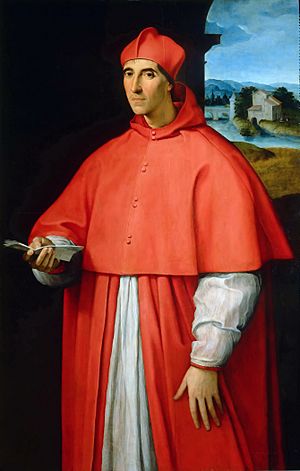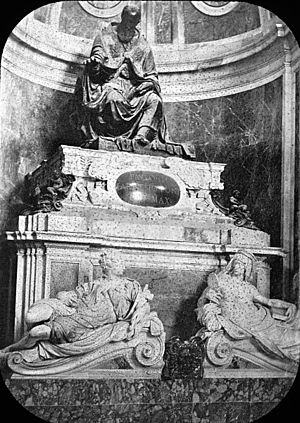Pope Paul III facts for kids
Quick facts for kids Pope Paul III |
|
|---|---|
| Bishop of Rome | |

Portrait of Pope Paul III by Titian, 1543
|
|
| Church | Catholic Church |
| Papacy began | 13 October 1534 |
| Papacy ended | 10 November 1549 |
| Predecessor | Clement VII |
| Successor | Julius III |
| Orders | |
| Ordination | 26 June 1519 |
| Consecration | 2 July 1519 by Leo X |
| Created Cardinal | 20 September 1493 by Alexander VI |
| Personal details | |
| Birth name | Alessandro Farnese |
| Born | 29 February 1468 Canino, Lazio, Papal States |
| Died | 10 November 1549 (aged 81) Rome, Papal States |
| Buried | St. Peter's Basilica |
| Children | Pier Luigi II Farnese Paolo Farnese Ranuccio Farnese Costanza Farnese Lucrezia Farnese |
| Previous post |
|
| Coat of arms |  |
| Other Popes named Paul | |
| Papal styles of Pope Paul III |
|
|---|---|
 |
|
| Reference style | His Holiness |
| Spoken style | Your Holiness |
| Religious style | Holy Father |
| Posthumous style | None |
Pope Paul III (born Alessandro Farnese; 29 February 1468 – 10 November 1549) was the leader of the Catholic Church and ruler of the Papal States. He served as Pope from October 13, 1534, until his death in November 1549.
He became Pope during a time of great change for the Catholic Church. This was after the city of Rome was attacked in 1527 and the Protestant Reformation had begun. Pope Paul III started the Counter-Reformation, which was the Catholic Church's response to the Protestant Reformation. He called the important Council of Trent in 1545. He also supported new Catholic groups like the Jesuits. He was known for helping his family gain power and wealth.
Paul III was a big supporter of artists, including Michelangelo. The famous scientist Nicolaus Copernicus even dedicated his book about the Earth orbiting the Sun to him.
Contents
Biography
Early Life and Family History
Alessandro Farnese was born in 1468 in Canino, which was part of the Papal States at the time. He was the oldest son of Pier Luigi I Farnese and Giovanna Caetani. His mother's family, the Caetani, had two previous popes. The Farnese family had been successful for many years. However, Alessandro becoming Pope greatly increased their wealth and power.
Alessandro received a good education in the humanities at the University of Pisa. He also studied at the court of Lorenzo de' Medici. In 1491, he joined the Roman Curia, which is the Pope's administration. In 1493, Pope Alexander VI made him a Cardinal.
As a young church leader, Alessandro had children. He had at least four children between 1500 and 1510. Their names were Costanza, Pier Luigi, Paolo, and Ranuccio. In 1505, Pope Julius II made his two oldest sons legitimate so they could inherit family lands. Later, Pope Leo X also made Pier Luigi and Ranuccio legitimate.
In 1509, Alessandro became the Bishop of Parma. He was not ordained as a priest until 1519, and then consecrated as a bishop shortly after. As Bishop of Parma, he decided to focus on reforming his diocese. Under Pope Clement VII, he became a Cardinal Bishop and the Dean of the College of Cardinals.
Becoming Pope
Papal Election in 1534
When Pope Clement VII died in 1534, Alessandro Farnese was chosen as the new Pope on October 13, 1534. He was named Pope Paul III. The cardinals thought he would be a good choice because he was not part of any main groups. Also, his health suggested he might not be Pope for very long, giving them time to choose a future leader. On November 3, Paul III was officially crowned.
Paul III made his grandsons, Alessandro Farnese (age 14) and Guido Ascanio Sforza (age 16), cardinals. This upset some people who wanted reforms in the Church. However, he soon appointed other respected leaders as cardinals, including Reginald Pole and Gasparo Contarini.

Important Actions as Pope
Paul III was the fourth Pope during the Protestant Reformation. He was the first to take strong steps to respond to Protestantism. In 1536, he called for a general council to meet in Mantua. However, this plan did not work out because Protestant leaders opposed it.
In 1536, Paul III asked a group of nine important church leaders to suggest ways to reform the Church. In 1537, they wrote a report called Consilium de Emendanda Ecclesia. This report showed many problems in the Church's administration and worship. It also suggested bold ideas to fix these problems. The report was widely printed, and the Pope was serious about reform. He knew that Emperor Charles V would not stop until these issues were addressed.
However, Protestants felt the report was not thorough enough. In the end, the committee's suggestions did not lead to many changes.
In England, King Henry VIII had taken strong actions against the Church. Because of this, Pope Paul III officially removed Henry VIII from the Catholic Church in December 1538.
In 1534, Paul III made a decision that helped merchants from all over the world, including Greeks and Turks, settle in Ancona. Ancona had become part of the Papal States. This decision helped Ancona become a very successful trading city for many years.
Around this time, family issues arose. To give his grandson Ottavio Farnese control of the dukedom of Camerino, Paul took it from the Duke of Urbino in 1540. He also started a conflict with his own people by putting heavy taxes on them. The city of Perugia rebelled but was defeated by Paul's son, Pier Luigi. The people of Colonna were also defeated in 1541. After these events, the Pope felt it was time to deal with religious differences.
In 1540, the Church officially recognized the new group started by Ignatius of Loyola, which became the Society of Jesus. In 1542, the Inquisition was reorganized. This was another step in the Counter-Reformation.
The Emperor wanted Rome to help bring peace with the German Protestants. So, the Pope sent Giovanni Morone to Haguenau and Worms in 1540. In 1541, Cardinal Gasparo Contarini took part in talks at the Conference of Regensburg. Contarini suggested the idea that "by faith alone are we justified." However, this idea did not replace the Catholic teaching of good works.
Even after the Regensburg Conference failed, the Emperor pushed for a larger council. This finally led to the Council of Trent, which began on March 15, 1545.
After a peace treaty in 1544, Emperor Charles V began to fight Protestantism by force. The Pope agreed to help in the war against the German Protestant leaders. Paul III likely agreed because he wanted to gain the duchies of Parma and Piacenza for his son, Pier Luigi. These lands belonged to the Papal States. The Emperor agreed, expecting soldiers and money from the Pope.
In Germany, the war began in the west. Hermann of Wied, the Archbishop of Cologne, had become Protestant in 1542. Emperor Charles started open war against the Protestant leaders and cities. Hermann was removed from the Church in 1546 and forced to step down in 1547. By the end of 1546, Charles V had taken control of South Germany. His victory at the Battle of Mühlberg in 1547 made him the supreme ruler in Germany.

Even though the Emperor had defeated the German Protestants, he did not support the Pope's plans for his son Pier Luigi. Their relationship became strained. It broke completely when Pier Luigi was forced out of Piacenza.
In 1547, the Pope's son was killed in Piacenza. Paul III blamed the Emperor for this. However, after the death of Francis I of France in 1547, the Pope lost a possible ally. This forced him to accept the Emperor's religious decisions.
Paul III wanted his son's lands back, but the Emperor refused to give up Piacenza. Pier Luigi's heir, Ottavio Farnese, also refused to give up Parma.
Paul III had a very strong argument about this with Cardinal Farnese. At 81 years old, he became so upset that he fell ill. He died on November 10, 1549.
Paul III was not able to stop the Protestant Reformation. However, during his time as Pope, the groundwork for the Counter-Reformation was laid. He officially removed Henry VIII of England from the Catholic Church in December 1538. His actions in Parma led to the War of Parma two years after his death.
Slavery and Sublimis Deus
In 1537, Pope Paul III issued a document called Sublimis Deus. This document is sometimes called the "Magna Carta" for the human rights of indigenous peoples of the Americas. It stated that "the Indians were human beings and they were not to be robbed of their freedom or possessions." Another document, Pastorale officium, said that anyone who did not follow this rule would be removed from the Church.
However, this document faced strong opposition from Spanish leaders. They said it went against their rights. The Pope then cancelled these orders the next year. Still, the original document continued to be used by people like Bartolomé de las Casas who supported the rights of Native Americans.
Some historians say that Sublimis Deus cancelled an earlier document from Pope Alexander VI. However, it still said that colonizers had a duty to convert native people to Christianity. One historian called it "the most important papal document relating to the condition of native Indians." It did not change the rule that enslaving Native Americans was allowed if they were considered "enemies of Christendom."
In 1545, Paul III changed an old law that allowed slaves to claim their freedom in Rome. This was because there were many homeless people in the city. The new rule applied to those who had become Christians after being enslaved and those born to Christian slaves. It confirmed the right of people in Rome to buy and sell slaves. In 1548, Paul allowed the buying and owning of Muslim slaves in the Papal States.
Also in 1537, Paul issued another document called Altitudo divini consilii. This document talked about how to spread Christianity and convert people. It also discussed how to properly give sacraments, especially baptism. This was very important during the early days of colonial rule when many indigenous people were baptized every day. The document also discussed how to handle local customs, like polygamy. After converting, men who had multiple wives had to marry their first wife. If they could not remember who the first wife was, they could choose the one they preferred.
Supporter of the Arts
One of the most important artworks created during Paul III's time was the Last Judgement by Michelangelo. This huge painting is in the Sistine Chapel of the Vatican Palace. Although Pope Clement VII first ordered the painting, Paul III continued the project and saw it finished in 1541.

As a cardinal, Alessandro had started building the Palazzo Farnese in central Rome. Its size and beauty grew even more after he became Pope. The palace was first designed by Antonio da Sangallo the Younger. Michelangelo later added more details, and Giacomo della Porta finished it. Like other Farnese family buildings, this impressive palace showed the family's power and wealth. The Villa Farnese at Caprarola is another example. In 1546, after Sangallo died, Paul appointed the elderly Michelangelo to oversee the building of St. Peter's Basilica. Paul also asked Michelangelo to paint two frescoes, 'Crucifixion of St. Peter' and 'Conversion of St. Paul' (1542–50), in the Pauline Chapel of the Vatican. These were Michelangelo's last frescoes.
Paul III ordered many different art and building projects. The artist Titian from Venice painted a portrait of the Pope in 1543. In 1546, Titian painted the well-known portrait of Paul III with his grandsons, Cardinal Alessandro Farnese and Ottavio Farnese, Duke of Parma. Both paintings are now in the Capodimonte Museum in Naples. The military defenses in Rome and the Papal States were also made stronger during his rule. He had Michelangelo move the ancient bronze statue of Emperor Marcus Aurelius to the Capitoline Hill. It became the center of the Piazza del Campidoglio.
Other Activities
Society of Jesus and Religious Orders
On September 27, 1540, Paul III officially approved the creation of the Society of Jesus in a papal document called Regimini militantis Ecclesiae. At first, Paul III limited the new group to only sixty members. However, he removed this limit when he saw how effective they were in their missionary work. In 1548, he allowed Saint Ignatius of Loyola to print his book, Spiritual Exercises.
Similarly, in 1540, Paul III approved the rules for the Somaschi Fathers. On June 9, 1544, he approved the rules for the Ursulines in a document called Regimini Universalis.
New Cardinals
During his time as Pope, Paul III appointed 71 new cardinals. Six of these were named secretly at first. Among those he named were his three future successors: Giovanni Maria Ciocchi del Monte, Marcello Cervini (who became Pope Marcellus II), and Gian Pietro Carafa. He also named Reginald Pole as a cardinal. Paul III wanted to make Desiderius Erasmus a cardinal in 1535, but Erasmus declined due to poor health and age.
Canonizations
Paul III officially recognized two saints during his papacy: Ginés de la Jara in 1541 and Abraham of Smolensk in 1549.
Death
On November 3, 1549, Paul III celebrated the anniversary of his coronation as Pope. However, he was very sad because of family issues and the loss of Parma to Emperor Charles V. He had a very heated argument with his cardinal nephew. He became so upset that he may have had a heart attack. On November 6, the Pope suddenly got a fever. He went to the Quirinale Hill, hoping the fresh air would help him. On November 7, his temperature increased.
Pope Paul III died on November 10, 1549, from a fever. It is said that he regretted his actions to help his family gain power on his deathbed.
Paul III's bronze tomb, made by Guglielmo della Porta, is in St. Peter's Basilica.
In Fiction
The novel La Chartreuse de Parme by Stendhal was inspired by a story about Alessandro Farnese's early life.
The character of Pope Paul III, played by Peter O'Toole in the TV series The Tudors, is loosely based on him. The young Alessandro Farnese is played by Diarmuid Noyes in the series Borgia and Cyron Melville in The Borgias. His image also appears on the cover of the Frank Zappa album We're Only In It For the Money.
See also
 In Spanish: Paulo III para niños
In Spanish: Paulo III para niños
- Catholic Church in the Azores, a church area created by Pope Paul III in 1534
- Cardinals created by Paul III


